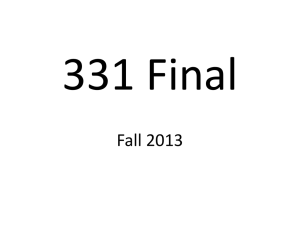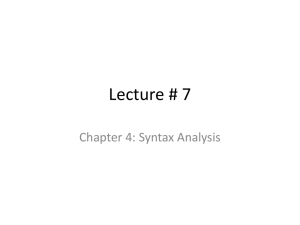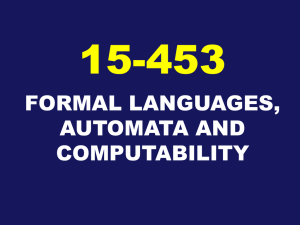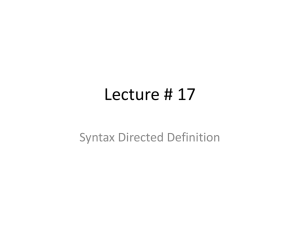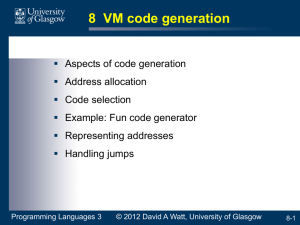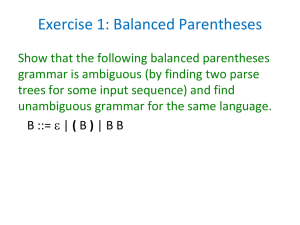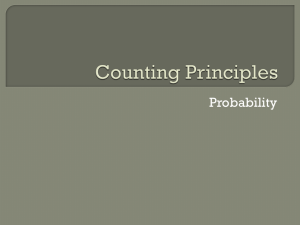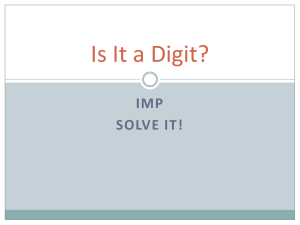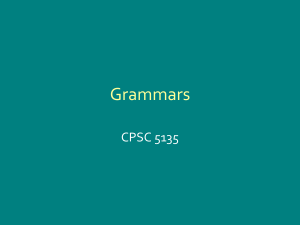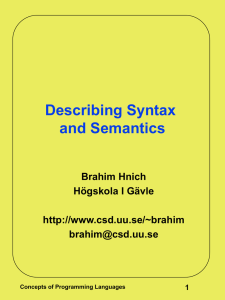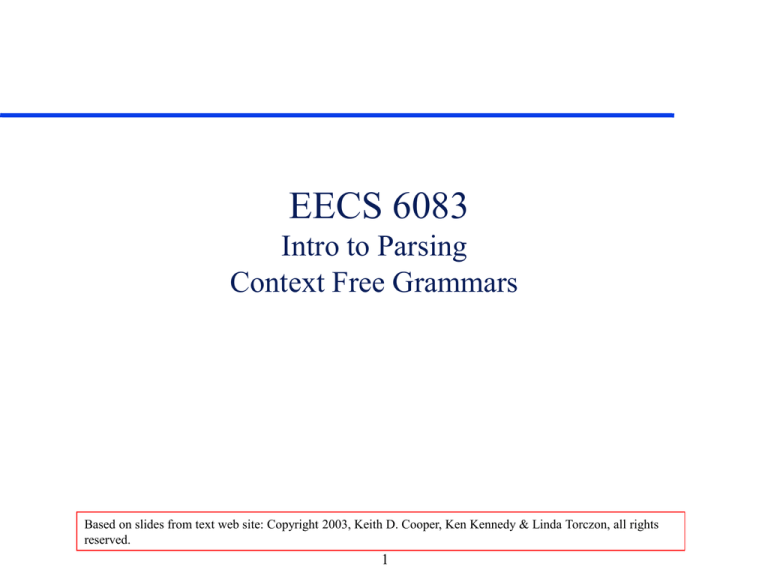
EECS 6083
Intro to Parsing
Context Free Grammars
Based on slides from text web site: Copyright 2003, Keith D. Cooper, Ken Kennedy & Linda Torczon, all rights
reserved.
1
Parsing
sequence of tokens
parser
syntax tree
Check the syntax (structure) of a program and create a
tree representation of the program
Programming languages have non-regular constructs.
Nesting
Recursion
Context-Free Grammars are used to express the syntax
for programming languages
2
Syntax vs. Semantics
Syntax – structure of the program, expressed with
grammatical rules.
Typically a Context Free Grammar (CFG) in Backus-Naur
form (BNF) or Exteneded Backus-Naur form (EBNF).
Semantics – meaning of the program, expressed with
descriptive text or with inference rules as in the
CoolAid Manual.
Consider the following English sentences:
I
subject
I
subject
fed
verb
fed
verb
the elephant.
object
the brick wall.
object
3
Both are syntactically
correct, but the second is
not semantically
reasonable.
Context Free Grammars
Comprised of:
a set of tokens or terminal symbols
a set of non-terminal symbols
a set of rules or productions which express the
legal relationships between the symbols
A start or goal symbol
Example:
(1) expr expr - digit
(2) expr expr + digit
Terminals: -,+, 0,1,2,…,9
(3) expr digit
Nonterminals: expr, digit
(4) digit 0|1|2|…|9
Start symbol: expr
4
Some Example CFGs
Palindromes over the alphabet {a, b, c}:
(a palindrome is a word that has the same spelling
backwards as forwards)
aabcbaa
5
Some Example CFGs (continued)
Palindromes over the alphabet {a, b, c}:
(a palindrome is a word that has the same spelling
backwards as forwards)
abba, c, abbcbcbba
CFG for Palindromes
SaSa
SbSb
ScSc
Sa
Sb
Sc
S
terminal symbols: {a, b, c}
non-terminal symbols: {S}
Goal symbol: S
6
Some Example CFGs (continued)
Balanced Parenthesis and Square Brackets
E.g. ( [ [ ] ( ( ) [ ( ) ] [ ] ) ] )
7
Some Example CFGs (continued)
Balanced Parenthesis and Square Brackets
E.g. ( [ [ ] ( ( ) [ ( ) ] [ ] ) ] )
The CFG:
B (B)
| [B]
| BB
|
8
Checking for correct Syntax
Given a grammar for a language and a program
how do you know if the syntax of the program is
legal?
A legal program can be derived from the start
symbol of the grammar.
9
Deriving a string
•The derivation begins with the start symbol
•At each step of a derivation the right hand side of a grammar rule is used
to replace a non-terminal symbol.
•Continue replacing non-terminals until only terminal symbols remain
(1) expr -> expr - digit
(2) expr ->expr + digit
(3) expr -> digit
(4) digit -> 0|1|2|…|9
expr expr – digit expr – 2 expr + digit - 2
Rule (1)
Rule (4)
Rule (2)
expr + 8 –2 digit + 8 – 2 3 + 8 – 2
Rule (4)
Rule (3)
Example Input:
3+8–2
10
Rule (4)
Rightmost and leftmost derivations
In a rightmost derivation the rightmost non-terminal is
replaced at each step.
expr expr – digit expr – 2 expr + digit – 2 expr + 8 –
2 digit + 8 – 2 3 + 8 – 2
corresponds to a postorder numbering in reverse of the
internal nodes of the parse tree
In a leftmost derivation the leftmost non-terminal is replaced
at each step.
expr expr – digit expr + digit – digit digit + digit – digit
3 + digit –digit 3 + 8 – digit 3 + 8 – 2
corresponds to a preorder numbering of the nodes of a parse
tree.
11
Parse tree
(1) expr -> expr - digit
(2) expr ->expr + digit
(3) expr -> digit
(4) digit -> 0|1|2|…|9
Root is the
start symbol
expr
expr
expr
Example Input:
3+8–2
digit
3
Leaves of parse tree
are terminal symbols
(tokens)
12
+
digit
digit
2
8
Interior nodes are
non-terminals
A More Useful Grammar
To explore the uses of CFGs,we need a more complex grammar
We denote this derivation: Expr * id – num * id
Such a sequence of rewrites is called a derivation
Process of discovering a derivation is called parsing
13
The Two Derivations for x – 2 * y
Leftmost derivation
Rightmost derivation
In both cases, Expr * id – num * id
The two derivations produce different parse trees
The parse trees imply different evaluation orders!
14
Derivations and Parse Trees
G
Leftmost derivation
E
E
Op
x
–
E
E
2
This evaluates as x – ( 2 * y )
15
Op
*
E
y
Derivations and Parse Trees
G
Rightmost derivation
E
E
This evaluates as ( x – 2 ) * y
16
E
Op
E
x
–
2
Op
E
*
y
Derivations and Precedence
These two derivations point out a problem with the grammar:
It has no notion of precedence, or implied order of evaluation
To add precedence
Create a non-terminal for each level of precedence
Isolate the corresponding part of the grammar
Force the parser to recognize high precedence subexpressions first
For algebraic expressions
Multiplication and division, first
Subtraction and addition, next
17
(level one)
(level two)
Derivations and Precedence
Adding the standard algebraic precedence produces:
This grammar is slightly larger
• Takes more rewriting to reach
level
two
some of the terminal symbols
• Encodes expected precedence
• Produces same parse tree
level
one
under leftmost & rightmost
derivations
Let’s see how it parses x - 2 * y
18
Derivations and Precedence
G
E
E
–
T
T
T
F
F
<id,x>
<num,2>
*
F
<id,y>
Its parse tree
The rightmost derivation
This produces x – ( 2 * y ), along with an appropriate parse tree.
Both the leftmost and rightmost derivations give the same expression, because
the grammar directly encodes the desired precedence.
19
Ambiguous Grammars
Our original expression grammar had other problems
This grammar allows multiple leftmost derivations for x - 2 * y
Hard to automate derivation if > 1 choice
The grammar is ambiguous
different choice
than the first time
20
Two Leftmost Derivations for x – 2 * y
The Difference:
Different productions chosen on the second step
Original choice
New choice
Both derivations succeed in producing x - 2 * y
21
Ambiguous Grammars
Definitions
If a grammar has more than one leftmost derivation for a single
sentential form, the grammar is ambiguous
If a grammar has more than one rightmost derivation for a single
sentential form, the grammar is ambiguous
The leftmost and rightmost derivations for a sentential form may differ,
even in an unambiguous grammar
Classic example — the if-then-else problem
Stmt if Expr then Stmt
| if Expr then Stmt else Stmt
| … other stmts …
This ambiguity is entirely grammatical in nature
22
Ambiguity: Dangling Else example
stmt if expr then stmt
| if expr then stmt else stmt
| other
Two parse trees for the legal sentence:
if E1 then if E2 then S1 else S2
23
Ambiguity: Dangling Else example (continued)
if E1 then ( if E2 then S1 else S2 )
stmt
if Expr (E1) then
stmt
if Expr (E2) then Stmt (S1) else Stmt (S2)
24
Ambiguity: Dangling Else example (continued)
if E1 then ( if E2 then S1 ) else S2
stmt
if Expr (E1) then
stmt
else stmt (S2)
if Expr (E2) then stmt (s1)
25
Deeper Ambiguity
Ambiguity usually refers to confusion in the CFG
Overloading can create deeper ambiguity
a = f(17)
In many Algol-like languages, f could be either a function or a subscripted
variable
Disambiguating this one requires context
Need values of declarations
Really an issue of type, not context-free syntax
Requires an extra-grammatical solution (not in CFG)
Must handle these with a different mechanism
Step outside grammar rather than use a more complex grammar
26
Ambiguity - the Final Word
Ambiguity arises from two distinct sources
Confusion in the context-free syntax
Confusion that requires context to resolve
(if-then-else)
(overloading)
Resolving ambiguity
To remove context-free ambiguity, rewrite the grammar
To handle context-sensitive ambiguity takes cooperation
Knowledge of declarations, types, …
Accept a superset of L(G) & check it by other means†
This is a language design problem
Sometimes, the compiler writer accepts an ambiguous grammar
Parsing techniques that “do the right thing”
i.e., always select the same derivation
27

